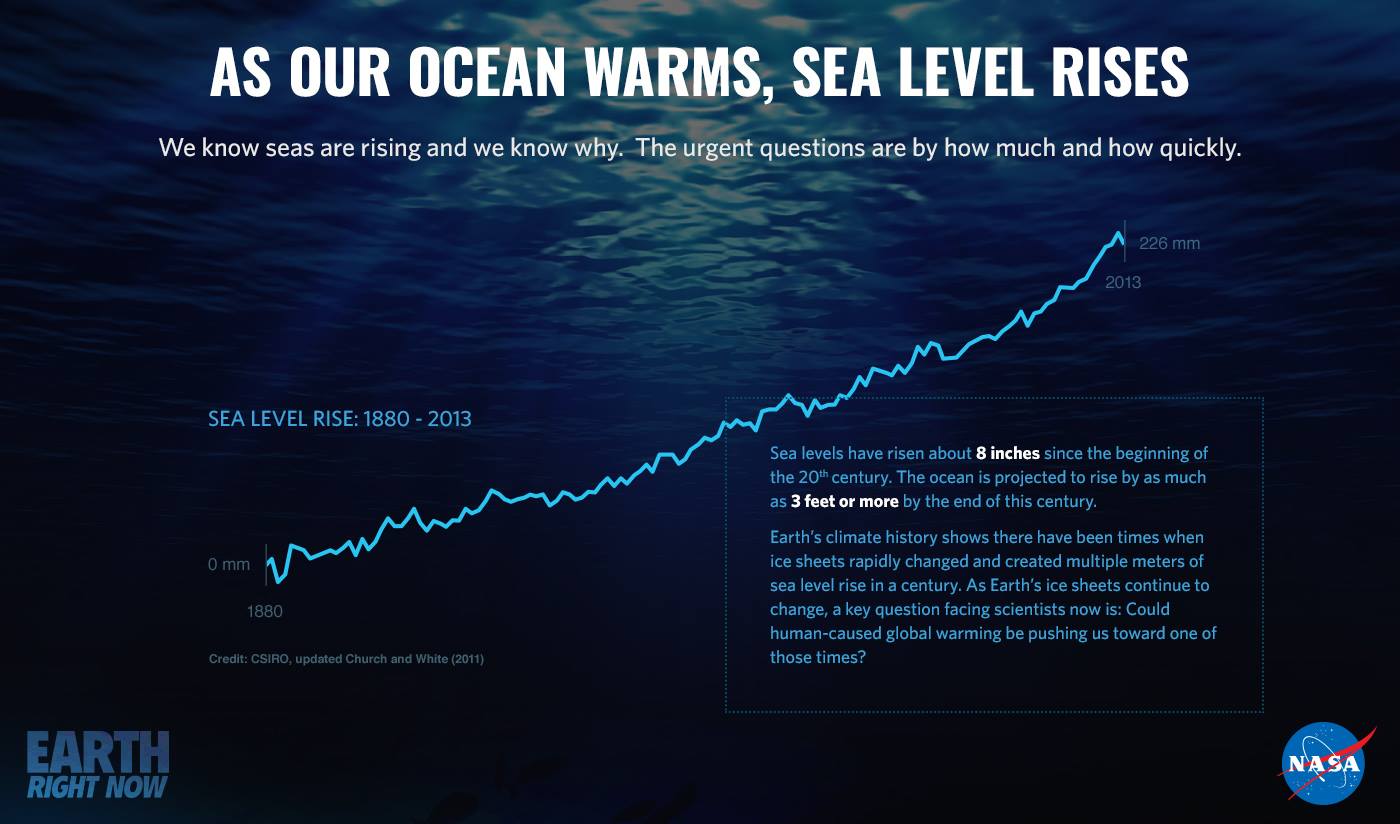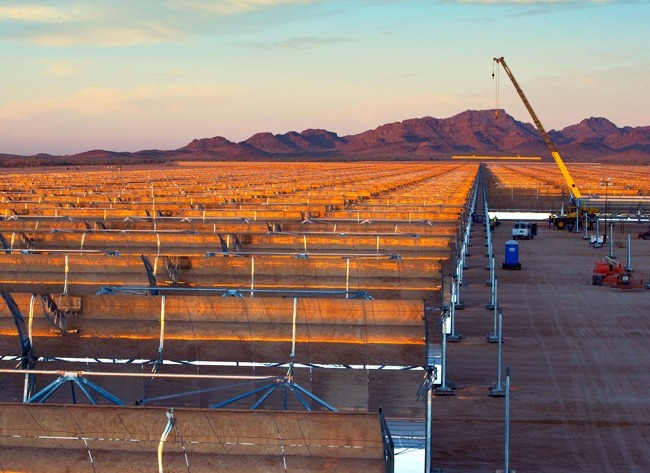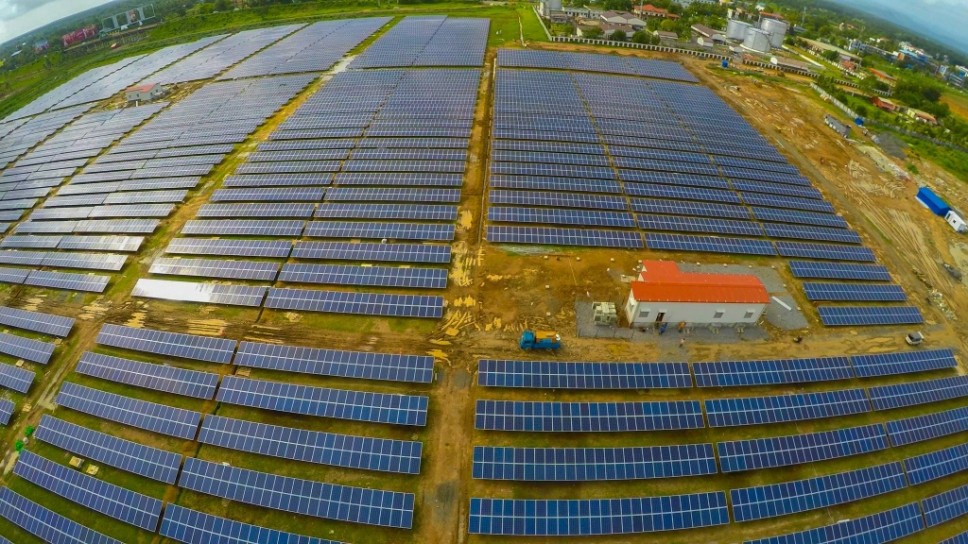Want to understand how much the sea levels are rising, and how quickly? New satellite imagery shows that the numbers don’t look good. But these tides can still turn if we work together to make a powerful effort right now.
Costa Rica Is Shutting Down All Zoos And Freeing Every Animal In Captivity
Costa Rica has announced that it will be the first country in the world to shut down its zoos and free the captive animals they hold. Costa Rica is an especially biodiverse country, holding about 4% of the world’s known species. Sadly, the country is contractually obligated to keep two of its zoos open for another decade. Still, after that, they plan to shut it down in favor of a cage-free habitat for the animals to live in.
Treehugger reports that the nation, which also recently banned hunting for sport, will close the last two zoos in the next 10 years and give the animals a more natural habitat in which to exist. They want to convey to the world that they respect and care for wild animals.
Environmental Minister René Castro says, “We are getting rid of the cages and reinforcing the idea of interacting with biodiversity in botanical parks in a natural way.”
We don’t want animals in captivity or enclosed in any way unless it is to rescue or save them.”
Any animals currently in captivity that would not survive in the wild will be cared for in rescue centers and wildlife sanctuaries. No new zoos will be opened.
U.S. Navy Invests in World’s Largest Solar Farm
The U.S. Navy is investing in what will be the largest solar farm in the world in order to provide power for 14 of its bases.
The climate of Arizona, where the two earlier phases of the Mesquite solar farm are already up and running, provides 300 days of sunshine a year. And the Navy’s deal to extend the farm is the largest purchase of renewable energy ever made by a U.S. federal government agency.
The solar farm project is one of a growing number being installed across what is known as the American Sun Belt-the southern states of America, which have expanding populations, plenty of sunshine but also large areas of arid and unproductive land.
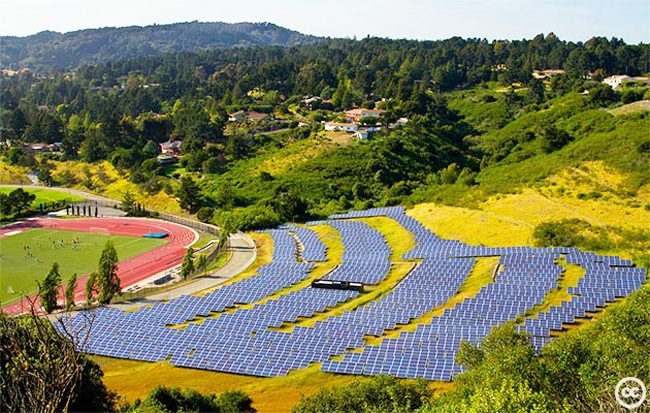
The price of solar panels has now fallen so far worldwide that, in sunny climes, they can compete on cost with any other form of energy generation. This new generation of huge solar farms produces as much power as a large coal-fired plant.
China and India are also building similarly massive installations, taking advantage of their own sun belts and desert regions. It is doubtful that Mesquite 3, huge as it is, will manage to remain the world’s largest for long.
Barren Land
In the same week that the U.S. Navy disclosed its plans, the central Indian state of Madya Pradesh announced it was to construct a 750 MW plant (one megawatt is roughly enough to supply 1,000 typical British homes) on barren, government-owned land in the country’s Rewa district.
It is claimed that it would be the world’s largest solar plant and the state’s energy minister, Rajendra Shukla, says the plan is to have the plant up and running by March 2017.
A number of other giant projects are also in the pipeline in India, as part of government plans for a dramatic expansion of the industry, although they have yet to be constructed.
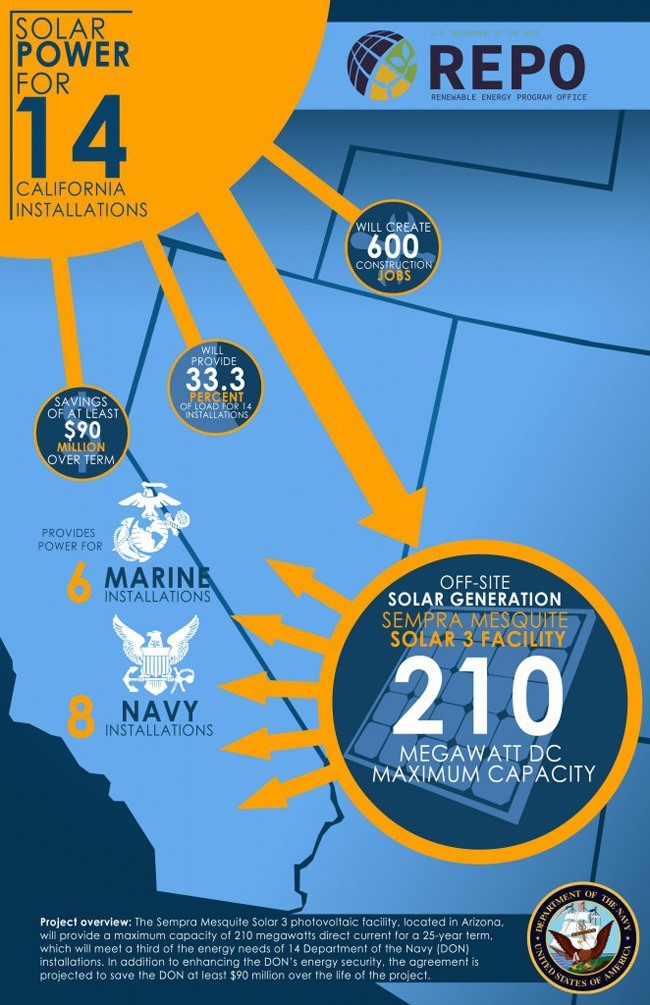
Mesquite 3, which will be sited 60 miles west of Phoenix, Arizona, will provide the Navy with 210 MW of direct power. This means the installation of more than 650,000 extra solar panels, which will move to track the sun as it crosses the sky, to get the maximum value from the intense desert sunshine. The Navy says it will save $90 million in power costs over the 25-year lifetime of the contract.
Some solar power plants in India have caused controversy because they need teams of people to wash off the layer of dust and particles from air pollution to keep the panels efficient. This uses a lot of scarce water.
However, in the cleaner desert air of Arizona, this is not a problem. The Navy boasts that Mesquite 3 will require no water, so saving “this precious resource for other needs.”
The building of the plant will require 300 construction workers but it will create only 12 long-term jobs. The plant also avoids controversy because it is sited on “previously disturbed land” and so is not damaging a pristine environment. It is also near existing power plants and transmission lines, so the plant will not need additional infrastructure.
Reduced Emissions
The Navy estimates that the station will reduce greenhouse gas emissions by 190,000 tons annually—the equivalent of taking 33,000 cars off the road.
Ray Mabus, the Secretary of State for the Navy, who opened the project, has been pushing hard for renewables to be used for military power generation.
In 2009, the U.S. Department of Defense was instructed by Congress to get 25 percent of its energy from renewable resources by 2025 but Mabus accelerated that goal and directed thatone gigawatt (1,000 MW) should be procured by the end of 2015.
The new contract adds to a 17 MW installation at Camp Lejeune, North Carolina and another of 42 MW at Kings Bay, Georgia. The Navy says that, in total, its renewable energy procurement will be 1.2 GW by the end of 2015, which is well ahead of target.
It will use the power for Navy and Marine Corps shore installations in California and surrounding states.
Opening the project at one of the installations, the Naval Air Station North Island, in California, Mabus said the project was “a triumph of problem solving” and would help increase the Department of the Navy’s energy security by diversifying the supply.
Internet Connection In Amazon Will Connect Villagers to Environmentalists
The Valhalla Movement takes very seriously the sensitivity involved in “charity” and make a large effort to detect an organization’s altruism before participating. We have personally been introduced to ACT, a team that partners with indigenous folks to protect the Amazon Rainforest. Their members are effective change-makers in line with our mission and we vouch for them.
In August 2015, a groundbreaking event took place in the village of Ulupuene in the Brazilian Amazon: internet connectivity arrived.
Through a collaborative partnership between the Amazon Conservation Team (ACT), Associação Indígena Ulupuene (AIU), and the nonprofit Synbio Consultoria em Meio Ambiente, the Waurá indigenous people of Ulupuene now have access to the web and can reach like-minded communities and organizations around the world to enlist support for the protection of the community’s rainforests and ancestral lands. The project was fully funded by ACT.
Though installation planning commenced in 2013, the village’s remote location in the Xingu Indigenous Reserve protracted the process, with coordination of logistics with outside actors constituting the greatest source of delay.
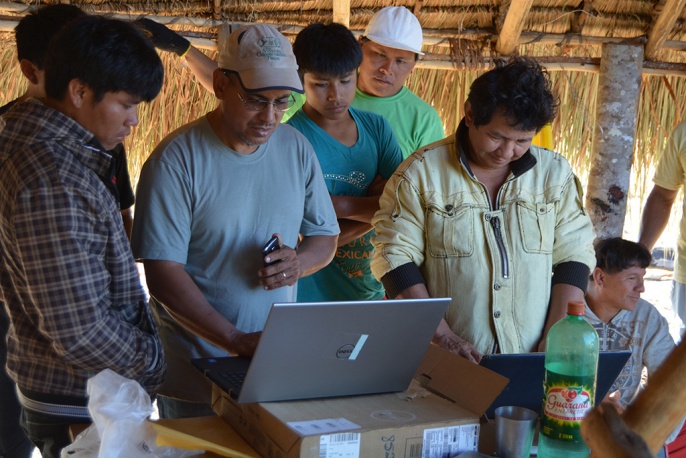
Numerous providers were consulted, including those offering radio transmission-prohibitive because of the necessity of building a 60-meter radio tower-and government-provided service, for which a very lengthy waiting list exists. Ultimately, satellite-mediated internet was deemed most viable.
Because configuration and registration required preexisting phone and internet connections, the equipment was set up in the neighboring town of Canarana. After technical adjustments, the satellite antenna travelled 250 miles in Synbio’s truck to Ulupuene where the Waurá, in anticipation, had already built a traditional communal “office”. Several community members already owned tablets and smartphones and were eager to receive news from beyond the reserve.
 Kumehin is now able to access the internet via her tablet.
Kumehin is now able to access the internet via her tablet.
Fittingly, upon inauguration, ACT co-founder Liliana Madrigal congratulated village chief Eleokar Waurá via the web, sending her best wishes to the community and emphasizing the many ways that the technology can be used for the benefit of the village and the protection of the forest. Eleokar thanked the partner institutions and expressed how the arrival of this tool had inspired his community.
Showerhead Utilizing Aerospace Technology Uses 70% Less Water
The average person in the U.S. uses between 80 and 100 gallons of water per day, with the largest uses of household water occurring in the toilet and the shower. Even though showers are one of the highest wasters of water, however, they are probably one of the personal experiences people would be willing to make the least compromises with. Nebia is a company that promises to not only improve your showering experience, but also help you use 70 percent less water.
After raising more than $2.5 million on Kickstarter, 17 days before the end of the campaign, the team is ready to start manufacturing, with the first showerheads expected to ship in May, 2016.
The six-person team behind Nebia, which includes several thermal fluid experts, has spent the last five years doing research, solving equations, and building prototypes in order to arrive at a new type of nozzle that, according to them, brings the first innovation in the industry in over 50 years. Meanwhile, the company has attracted investments from Tim Cook of Apple and Eric Schmidt of Alphabet.

The result is impressive. On average, Americans take about eight minutes to shower, which results in using 20 gallons of water. With Nebia, for the same amount of time, one will use up only six gallons, or 70 percent less water. With an initial price of $299, for the average U.S. home, Nebia pays for itself in less than two years.

CEO and co-founder Philip Winter told TechCrunch that “If everyone in California were to switch over to this showerhead, we think we could reduce the state water’s use by 1.5 percent.” In the future, the company also wants to make the technology cheaper and available to developing countries where water is scarce.
“The last half century of nozzle technology has completely changed what we can do with droplet size and distribution, however this technology has only been applied to very specialized fields, like rocket engines and medical devices. We used these same tools and technology to develop Nebia. What we do is atomize streams of water into millions of tiny droplets. By doing this we can achieve 10 times the surface area of water compared to a regular shower and use a fraction of the volume,” says co-founder and CTO Gabriel Parisi-Amon.
According to the creators, Nebia is easy to install – users simply unscrew their existing shower and screw on Nebia with a wrench, plumbers tape, and an included adhesive, without the need to break tiles or call the plumber. The showerhead can slide up and down, pivot at an angle, and includes a portable wand.

India Built The World’s First Solar-Powered Airport
The southern Indian city of Kochi is now the proud home of the world’s first solar-powered airport.
On Aug. 18, the Cochin International Airport Limited (CIAL)-India’s fourth largest international airport in terms of passenger traffic-commissioned a 12 mega watt (MW) solar power project. The airport already had a 1MW solar power plant, which can produce 4,000 units of electricity daily.
With its new solar plant, the airport can now produce 60,000 units of electricity every day, which is more than enough to meet its daily requirement.
“We initiated a pilot project in February 2013 as part of our plan to shift to renewable energy by setting up a 100 kilo watt unit,” VJ Kurian, managing director of CIAL told Quartz in a telephone interview. “When we found that feasible, we set up a 1MW unit in November 2013.”
“We did not want to be identified as just another airport and be confined to it,” Kurian added.
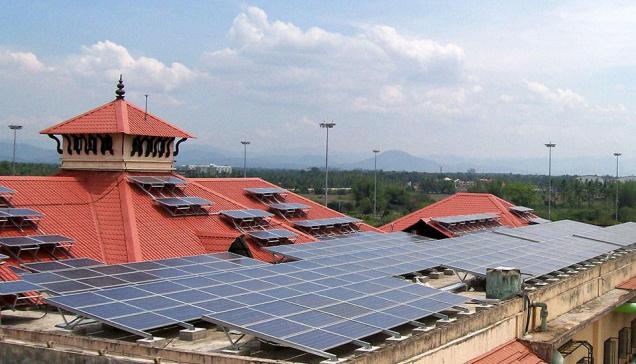
After the airport found the 1MW project financially viable, it invited tenders to set up a 12MW project within the airport complex. “Work on the 12MW project started in February 2015 and was completed in less than six months” Kurian said.
Spread across 45 acres of land-equivalent to 25 football fields-the project was built by German engineering company Bosch for Rs62 crore ($9.5 million). The area for the solar unit was earlier designated for setting up a cargo handling facility.
Since the airport expects to produce more than what it is likely to consume, CIAL is planning to feed some of the power into the state grid.
“Over the next 25 years, this green power project will avoid carbon dioxide emissions from coal fired power plants by more than 3 lakh metric tons, which is equivalent to planting 3 million trees or not driving 750 miles,” CIAL said in a statement.
Meanwhile, close on the heels of Kochi, another Indian airport has also laid out plans to focus on solar. On Aug.18, Kolkata’s Netaji Subhas Chandra Bose International Airport, said that it plans to set up a 15 MW solar power plant on 60 acres of land.
India is currently in the midst of ramping up its solar power generation. The Narendra Modi government has plans to increase the country’s solar power capacity from the existing 4GW (gigawatt) to 100GW (gigawatt)by 2022.
To fund such an ambitious expansion, the government expects an investment of $100 billion in the sector in the next seven years. Some of Asia’s biggest billionaires-including SoftBank’s Masayoshi Son, Gautam Adani and Anil Ambani-have already promised massive investments in the sector.
Alongside, smaller establishments like Kochi’s airport are also joining the party.
This Ingenious $20 Lamp Gets All Its Energy From Gravity
The ingenious GravityLight-a light that gets all its energy from its own weight-first appeared about three years ago. We wrote about it as it was launching on Indiegogo and went on to raise $399,590.
It provides free light (after you’ve bought it). It’s cheap. And it has none of the environmental or health side-effects as do other light alternatives in the developing world. But even all those things aren’t necessarily enough if it’s to reach its potential. If the company and foundation behind the device are to make it a success, they need a reliable product; they need to distribute it in places where distribution can be difficult; and, more fundamentally, they need to explain why someone should buy a GravityLight when there’s plenty of good, cheap solar on the market today.
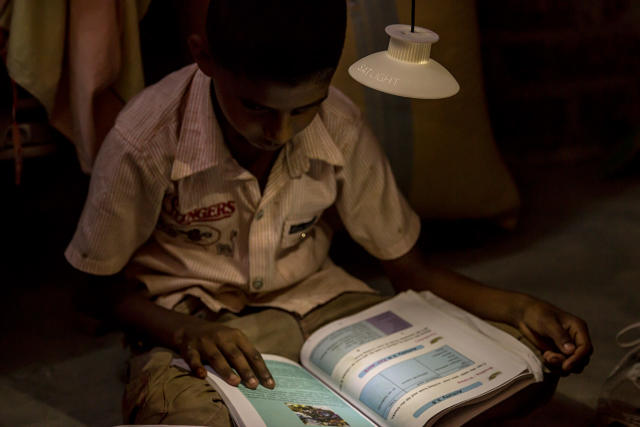
Thankfully the company seems to have most of the questions answered, as least so far.
The light has a gear-train and DC generator. As a heavy object pulls down on one side, it creates a force that’s converted into electricity. The lamp can last for hours on a single lift to one side, and, of course, that lift is renewable: When one side drops to balance, you just hoist it up again. With a string of mini-lights attached, it can illuminate a small room. And, importantly, without the problems that come with kerosene lamps (fumes, fire), which are still widely used in off-grid places.
After the first campaign, GravityLight sent the device to organizations and individuals in 26 countries. They tested it and reported back about what they liked and didn’t-feedback that’s now been incorporated into a version two. Children apparently liked swinging on it, meaning it could break, and some families complained that lifting 22 pounds was too much for them. The new version, which launches next spring, has a stronger plastic housing, and a new pulley system that effectively reduces the weight by three-quarters. It also comes with auxiliary mini-lights, or “SatLights,” that can be extended in series.

“The SatLights have really revolutionized the experience,” says commercial director Caroline Angus. “Now someone can be reading while someone else is cooking, rather than there just being this one light on that one person, or a narrow part of the room.”
This story is part of our series, How’s That Working Out For You, where we check in on projects we’ve covered in the past to see if they’ve come to fruition, or turned out to just be vaporware.
With the proceeds from a second Indiegogo campaign, GravityLight is now setting up an assembly line in Kenya. The lamp will cost $20 and be distributed through door-to-door ( Avon Lady-type) networks, farmer groups, and more traditional market stalls.
Angus sees a wide range of people buying the product, from families who currently use kerosene lamps, to people who have have grid power but are afraid of blackouts. “It’s everyone from people on $2 a day to the slightly more affluent who are just conscious of the next power cut because maybe they haven’t already charged a solar light,” she says. The GravityLight is more dependable than a solar lamp, she says. It’s on-demand, whereas solar power is dependent on the weather, or your foresight in charging up a battery ahead of time.
It certainly sounds like GravityLight has answers to the big questions. But, it’s still early days, and we won’t know for sure until the new product hits the streets next year.
Humans Are Set To Wipe An India-Sized Chunk Of Forest Off The Earth By 2050
By 2050, an area of forests the size of India is set to be wiped off the planet if humans continue on their current path of deforestation, according to a new report. That’s bad news for the creatures that depend on these forest ecosystems for survival, but it’s also bad news for the climate, as the loss of these forests will release more than 100 gigatons of carbon dioxide into the atmosphere.
The report, published Monday by the Center for Global Development (CGD), found that, without new policies aimed at cutting back on deforestation, 289 million hectares (about 1,115,840 square miles) of tropical forests will be cleared away. That’s a chunk, the report states, that’s equal to one-seventh of what the Earth’s total tropical forest area was in 2000. And, according to the report, the 169 gigatons of carbon dioxide that this deforestation will unleash is equal to one-sixth of the carbon budget that humans can emit if they want to keep warming below 2°C – the level that’s generally viewed as the maximum warming Earth can endure while still avoiding the most dangerous climate impacts (and even 2°C is seen by many experts as too high).
The study, unlike other recent studies on deforestation, projects that in a business-as-usual scenario, in which the world doesn’t make any effort to reduce deforestation, tropical deforestation will increase, rather than decrease. According to the study, tropical deforestation rates in such a scenario will likely climb steadily in the 2020s and 2030s and then speed up around 2040, “as areas of high forest cover in Latin America that are currently experiencing little deforestation come under greater threat.”
The study does point to one change in policy that would cut deforestation rates and help alleviate climate change: a price on carbon. According to the report, a price of $20 per ton of carbon would keep 41 gigatons of carbon dioxide from being emitted between 2016 and 2050, and a price of $50 per ton would keep 77 gigatons from being emitted.
“Our analysis corroborates the conclusions of previous studies that reducing tropical deforestation is a sizable and low-cost option for mitigating climate change,” the study’s authors write. “In contrast to previous studies, we project that the amount of emissions that can be avoided at low-cost by reducing tropical deforestation will increase rather than decrease in future decades.”
The study also noted that, if all tropical countries put in place anti-deforestation laws that were “as effective as those in the Brazilian Amazon post-2004,” then 60 gigatons of carbon dioxide would be kept out of the atmosphere. Brazil took action against deforestation in 2004 and 2008, and deforestation rates in the country have fallen from 27,000 square kilometers (about 10,424 square miles) in 2004 to 7,000 square kilometers (about 2,700 square miles) in 2010. According to the Climate Policy Initiative, this slowdown in deforestation rates helped keep about 2.7 billion tons of carbon dioxide in these forests and out of the atmosphere.
Forests can act as major carbon sinks, but for some forests, that role may be changing. A study from this year published in Nature documented the “long-term decline of the Amazon carbon sink,” which the study says could be occurring due to changes in climate. The study also points to increasing tree mortality rate – via deforestation – as another factor in the forests’ decreasing ability to store carbon.
Monday’s study noted that decreasing emissions from deforestation is a relatively cheap way for countries to reduce their overall emissions. If countries implemented a system in which wealthy countries paid tropical countries to keep their forests intact, those payments by wealthy countries would constitute a cheaper way to fight climate change than some alternatives.
“Conserving tropical forests is a bargain,” CGD research fellow and report co-author Jonah Busch said in a statement. “Reducing emissions from tropical deforestation costs about a fifth as much as reducing emissions in the European Union.”
Other studies have warned of the danger the world is in if countries don’t curb rates of deforestation and forest degradation. A study published this week in Science warned that, without policy changes, the world’s forests will become increasingly broken into unconnected patches – a fragmentation that will endanger the species that live in the forests.
“I fear a global simplification of the world’s most complex forests,” Simon Lewis, lead author of the study and tropical forest expert at the University of Leeds said in a statement. “Deforestation, logging and road building all create fragmented patches of forest. However, as the climate rapidly changes the plants and animals living in the rainforest will need to move to continue to live within their ecological tolerances. How will they move? This is a recipe for the mass extinction of tropical forest species this century.”
Activate the Future: Get Your Early Bird Tickets for YES 2015
Announcing the 2nd Annual Youth Ecovillage Summit This year’s gathering will take place in the beautiful Appalachian Mountains of North Carolina, at Earthaven Ecovillage. With eighty year-round residents and decades of off-the-grid living, Earthaven is the perfect place to host this year’s event. October will be especially beautiful, as the leaves begin to turn a dazzling display …
Google Maps can now tell you if it’s worth installing solar panels on your roof
Google wants to help you harness the power of the sun. A new service called Project Sunroof aims to provide a “treasure map” of solar energy with the help of Google Maps. Sunroof gives homeowners detailed information about how much solar power their roof can generate and how much money they could save on electricity costs by adding solar panels.
Sunroof uses data from Google Maps that previously had no practical application. For instance, Sunroof uses Maps’ 3D-modeling to calculate the amount of space a building’s roof has for solar panels. The service also analyzes the positioning of the sun over the course of a year, as well as the type of cloud cover and temperature the neighborhood usually experiences. It even considers the amount of shade cast by nearby objects.
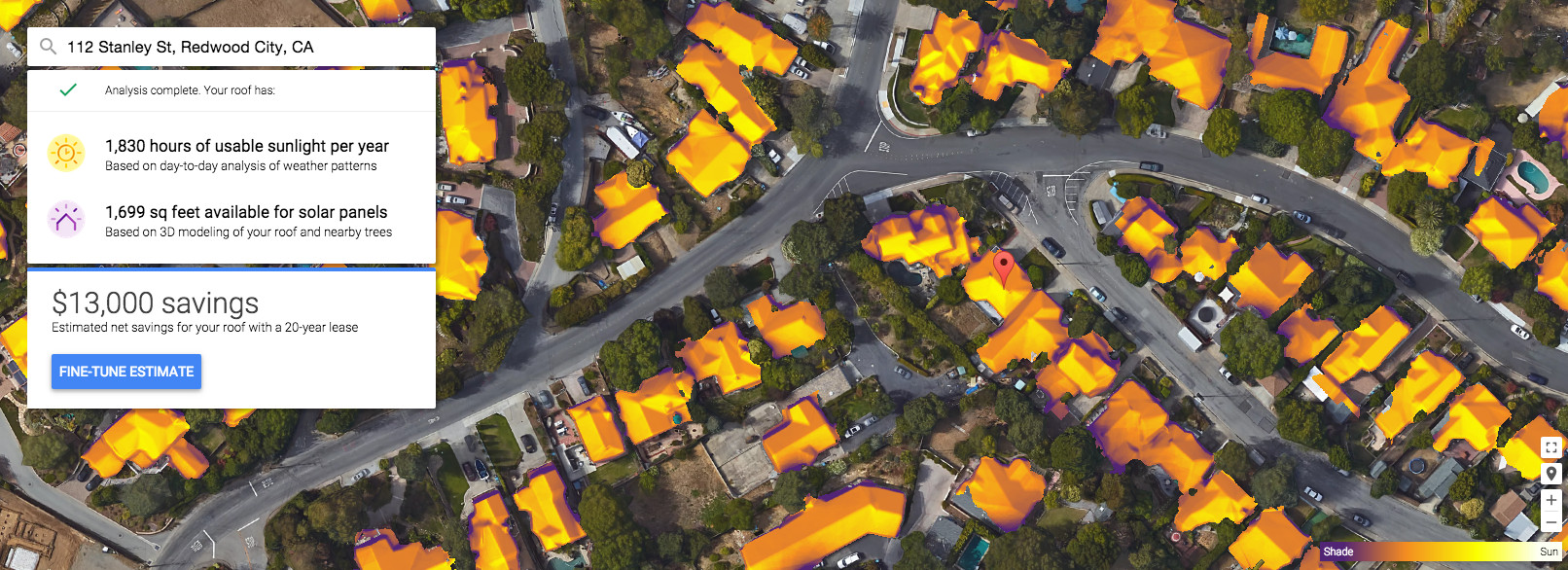
Switching to solar energy can be a win-win scenario for many households. Harnessing a free power source can help save money on the electric bill while ever-so-slightly decreasing the world’s dependance on greenhouse-gas-producing fossil fuels. But it’s possible your home doesn’t get enough sunlight, and it can be hard to know exactly how much money you’ll save. Sunroof can tell users how many hours of usable sunlight they’ll get a year, as well as how much available space they have for solar panels on their roof.
If a family decides those cost-saving benefits are good enough, Sunroof will suggest installers nearby who can load the panels. Installing solar panels isn’t cheap, costing upwards of $20,000, but the average homeowner can save about $20,000 by switching to solar energy – if their home is in the right spot.
Right now, Project Sunroof is only available for people living in Boston, San Francisco, and Fresno, but Google plans to expand the service to the entire country.
This zero-waste grocery store has no packaging, plastic or big-name brands
Forget Whole Foods.
The Original Unverpackt is the first Zero Waste Grocery store in the World.
The idea came to be when founders Sara Wolf and Milena Glimbovski were determined to create “something impossible.” They used crowd funding to back the store and decided to challenge the traditional shopping experience. The store’s mission is to stop contributing to waste that’s caused by food packaging by selling groceries in a sustainable manner (16 million tonnes per year in Germany alone).
Three studies conducted in 2013 found that 12 million tonnes of food waste is accumulated annually amounting to a price tag of £19 billion a year. This figure isn’t only swelling landfills, but also contributes to 20 million tonnes of the nation’s greenhouse gas emissions annually.
Sara Wolf and Milena Glimbovski are the creators of Original Unverpackt
The same study states that 75% of this waste could have been easily sidestepped with more efficient infrastructure.
In terms of pricing, some of the products offered at Original Unverpackt are more expensive, mainly because they’re organic. But other items are comparable, if not cheaper than standard supermarkets. The “fill-your-own-container” idea can save customers money by preventing them from overspending on food. Customers can bring their own containers, such as tubs and recycled bags-which are also sold at the store-and pay based on the weight of the products.
Although many believe that the sustainable supermarket model is unlikely to reach North America anytime soon, awareness and demand for low-waste alternatives will undoubtedly speed up the process.
A customer shops at the Original Unverpackt store in Berlin
Sources: torontoist.com, wordpress.com, gannett-cdn.com, timesofoman.com

